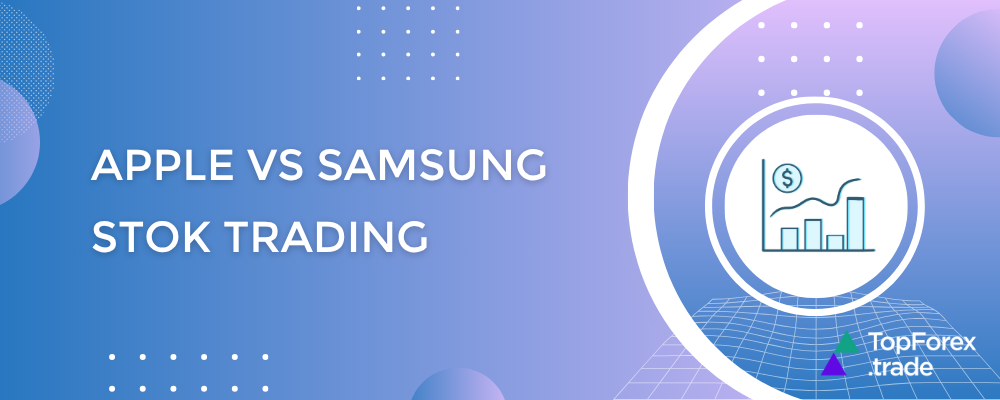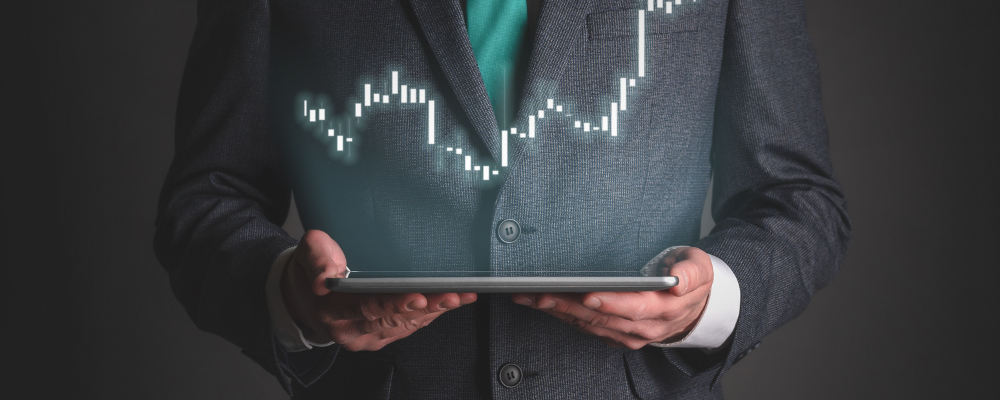Apple or Samsung? Comparing fundamentals, trends, and trading strategies

The rivalry between Apple (AAPL) and Samsung (005930.KS) has shaped the tech industry for years. Both companies remain dominant players in smartphones, wearables, semiconductors, and AI-driven innovations. But for traders, which stock presents better opportunities this year?
In this article, we’ll compare Apple and Samsung stocks based on fundamentals, technical trends, and trading strategies, helping you decide where to allocate your capital.
Apple vs. Samsung: key fundamentals
Financial performance and growth prospects
Apple (AAPL):
- Revenue streams: iPhone sales (40%), Services (25%), Wearables (10%), Mac & iPad (15%).
- 2025 catalysts: AI integration in iOS, Vision Pro expansion, and possible new product launches (e.g., AR glasses).
- Valuation: P/E ~30 (historically high, but justified by brand loyalty and cash reserves).
Samsung (005930.KS):
- Revenue streams: Semiconductors (40%), Smartphones (30%), Displays (15%), Home Appliances (10%).
- 2025 catalysts: AI chip demand, foldable phone growth, and memory market recovery.
- Valuation: P/E ~12 (cheaper than Apple, but more cyclical).
Verdict: Apple is a stable blue-chip, while Samsung offers higher volatility with semiconductor exposure.
Technical analysis and price trends
Apple (AAPL) stock outlook
- Current trend (2025): AAPL has steadily increased since 2023, supported by buybacks and strong earnings.
- Key levels:
- Support: $190 (200-day MA)
- Resistance: $220 (all-time high)
- Potential trade: Buy near $195 with a target of $220, stop-loss at $180.
Samsung (005930.KS) stock outlook
- Current trend: Samsung is more volatile, influenced by chip demand and Korean market sentiment.
- Key levels:
- Support: ₩75,000
- Resistance: ₩90,000
-
Potential trade: Buy near ₩78,000 if semiconductor demand rises, target ₩90,000, stop-loss at ₩72,000.
Apple vs. Samsung: trading strategies

Swing trading (medium-term)
Swing trading (holding positions for days/weeks) works well for both stocks, but requires different approaches due to their distinct volatility patterns.
Apple (AAPL) – Trading pullbacks to key moving averages
- Why it works: Apple tends to respect technical levels due to strong institutional ownership.
- Key levels:
- 50-day MA (~$195 in 2025): Short-term pullback zone
- 200-day MA (~$190): Stronger support level
-
Strategy:
- Buy when AAPL pulls back to $195 with RSI < 40 (oversold)
- Target 5-8% bounce toward $210-$220
- Stop-loss below $185 (violation of 200-day MA)
More about: Forex risk management tools: automatic trading with popular market orders
-
Example: In Q1 2025, AAPL dipped to $192 (near 200-day MA) before rallying 12% in 3 weeks.
Samsung (005930.KS) – Breakout trading
- Why it works: Samsung moves more sharply on semiconductor news.
- Key resistance levels:
- ₩85,000 (psychological resistance)
- ₩90,000 (2024 high)
-
Strategy:
- Buy when price closes above ₩85,000 on above-average volume
- Target ₩90,000 (5.8% gain) or ₩95,000 (11.7% gain)
- Stop-loss below ₩82,000 (3.5% risk)
-
Example: In Feb 2025, Samsung broke ₩85,000 after TSMC’s strong earnings and gained 9% in 10 days.
Pro tip: Use Bollinger Bands® with Samsung – price often reverts after touching the upper band during breakouts.
Earnings and news-based trading
These stocks react very differently to fundamental catalysts.
Apple’s key triggers:
1. iPhone Sales Data (Quarterly Reports)
- Watch for:
- Emerging market growth (India, Southeast Asia)
- Average selling prices (ASP)
- Typical move: ±5-7% on earnings day
- Strategy: Buy calls/CFDs if ASP rises >$950; buy puts if China sales decline >10% YoY
2. Fed rate decisions
- AAPL behaves like a “cash proxy” due to $ 200 B+ reserves
- Rate cuts → AAPL outperforms (cheaper financing for buybacks)
- Rate hikes → Short-term pressure (money flows to bonds)
3. AI Announcements
- Any iOS AI features could trigger 3-5% rallies
- Example: June 2025 WWDC AI tools announcement caused a 4.1% gap up
Samsung’s key triggers:
1. Semiconductor reports (monthly)
- DRAM/NAND flash pricing (from TrendForce)
- NVIDIA/AMD earnings (indirect demand indicator)
- Typical move: ±8-12% on major chip news
2. Galaxy launch events
- Foldable phone pre-order numbers crucial
- Example: Z Fold 7 pre-orders beating estimates caused 6.3% surge
3. Geopolitical Risks
- Korea-Japan trade relations
- China export controls on rare earth metals
Trading plan:
- Apple: Trade earnings strangles (buy both calls & puts)
- Samsung: Use news-trading bots for chip price alerts
Pairs trading (advanced strategy)
This market-neutral strategy profits from relative performance.
When to go long Apple/short Samsung:
-
Macro conditions:
- Strong USD (hurts Korean exports)
- Rising U.S. tech valuations
- Fed dovish + BOE hawkish
-
Technical setup:
- AAPL/Samsung ratio > 0.0025 (1 AAPL share = ₩100,000 Samsung)
- Samsung underperforming KOSPI index
When to reverse (short Apple/long Samsung):
-
Macro conditions:
- Weak USD (helps Korean exporters)
- AI chip demand surge
- Memory price rebound (DRAM +20% YoY)
-
Technical setup:
- AAPL/Samsung ratio < 0.0020
- Samsung breaking ₩85,000 with volume
Broker-specific advantages for these strategies
- XM/Exness: Best for news trading (ultra-fast execution)
- BlackBull: Ideal for pairs trading (tight ECN spreads)
- eToro: Copy trading works for Apple swing strategies
- Plus500: Guaranteed stops crucial for Samsung breakouts
Final verdict: Apple vs. Samsung – which stock is better to trade in 2025?

✅ Choose Apple (AAPL) if you want:
- Stability and dividends – Reliable long-term growth, strong cash flow, and shareholder returns.
- Lower volatility – Steadier price action, ideal for swing trading pullbacks to moving averages (e.g., $190–$200 support).
- Catalyst-driven trades – Play iPhone sales, Fed policy, and AI announcements (e.g., iOS 19 upgrades).
✅ Choose Samsung (005930.KS) if you want:
- Higher upside potential – Explosive moves from semiconductor cycles and foldable phone demand.
- News-based trading – React to chip pricing (DRAM/NAND), NVIDIA/TSMC earnings, and geopolitical shifts.
- Breakout opportunities – Trade key levels (₩85,000–₩90,000 resistance).
Top 5 FX and CFD brokers to start stock trading
If you want to trade AAPL or Samsung CFDs, here are the top 5 brokers in 2025:
XM Group for low-cost FX trading
-
Why choose XM?
- Tight spreads, 1:30 leverage on stocks.
- 1,000+ instruments (stocks, forex, commodities).
- Strong regulation (CySEC, ASIC, FSC).
-
Minimum deposit: $5 (great for beginners).
Exness – best for fast execution
-
Why choose Exness?
- Ultra-low latency execution (good for scalpers).
- Offers stock CFDs, crypto, and metals.
- 1:10 leverage on stocks.
-
Minimum deposit: $10.
BlackBull Markets – best for pro traders
-
Why choose BlackBull?
- ECN trading (institutional-grade liquidity).
- Advanced platforms (MetaTrader 4/5, TradingView).
- 1:20 leverage on stocks.
-
Minimum deposit: $50.
eToro – best for Social and Copy trading
-
Why choose eToro?
- Copy pro traders (great for beginners).
- Fractional shares (buy Apple stock for $10).
- No leverage on real stocks (CFDs have 1:5 leverage).
-
Minimum deposit: $50.
Risk disclaimer: eToro is a multi-asset platform which offers both investing in stocks and cryptoassets, as well as trading CFDs.
CFDs are complex instruments and come with a high risk of losing money rapidly due to leverage. 61% of retail investor accounts lose money when trading CFDs with this provider. You should consider whether you understand how CFDs work, and whether you can afford to take the high risk of losing your money.
This communication is intended for information and educational purposes only and should not be considered investment advice or investment recommendation. Past performance is not an indication of future results.
Copy Trading does not amount to investment advice. The value of your investments may go up or down. Your capital is at risk.
Don’t invest unless you’re prepared to lose all the money you invest. This is a high-risk investment and you should not expect to be protected if something goes wrong. Take 2 mins to learn more.
eToro USA LLC does not offer CFDs and makes no representation and assumes no liability as to the accuracy or completeness of the content of this publication, which has been prepared by our partner utilizing publicly available non-entity specific information about eToro.
Plus500 – best for risk management with CFDs
-
Why choose Plus500?
- Advanced charting and risk tools (guaranteed stop-loss).
- 1:5 leverage on stocks.
- Simple, user-friendly platform.
-
Minimum deposit: $100.
79% of retail investor accounts lose money when trading CFDs with this provider. You should consider whether you can afford to take the high risk of losing your money.
Plus500EE AS is authorised and regulated by the Estonian Financial Supervision and Resolution Authority (Licence No. 4.1-1/18).
Related articles:
Apple vs. Samsung stock trading - FAQ
